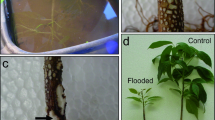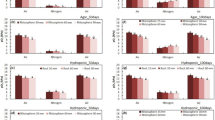Abstract
Rumex thyrsiflorus, Rumex crispus andRumex maritimus show a differential flood-tolerance in the river ecosystem in the Netherlands.R. thyrsiflorus occurs at high-elevated habitats and is flood-intolerant, the other two species occur at lower-elevated habitats and are flood-tolerant. We compared their respiratory activity under aerobic and anaerobic conditions in the root environment and quantified the internal gas transport. The results indicate that aerial oxygen can be used for root respiration in both aerobically and anaerobically grown plants. The amount of oxygen used via internal aeration increased with decreasing oxygen concentration in the root environment. Aerobically grown plants ofR. maritimus andR. crispus already showed a high internal aeration, but there was a significant increase in internal oxygen transport in anaerobic plants, where new, aerenchymatous roots had formed. This indicates the functional significance of new root formation for respiration in these species upon hypoxia. After two weeks of anaerobiosis, more than 50% of the total respiration of the roots of young plants ofR. maritumus and 40% of roots of young plants ofR. crispus was due to internal aeration at low oxygen concentrations in the root environment.
InR. maritimus both young and old plants performed in this way, inR. crispus only young plants, whileR. thyrsiflorus showed some internal aeration, but this was hardly detectable. These differences can be explained on the basis of a different morphology and concomitant diffusive resistance of both root and shoot system.
In experiments with different submergence levels of the shoot, the amount of internal aeration was positively correlated to the total leaf area protruding above the water surface inR. maritimus. This indicates a functional significance of the petiole and leaf elongation response upon total submergence of this species.
Similar content being viewed by others
References
Arber A 1920 Water Plants. Cambridge University Press, Cambridge.
Armstrong W 1979 Aeration in higher plants. Adv. Bot. Res. 7, 225–332. Academic Press, London.
Armstrong W and Gaynard T J 1976 The critical oxygen pressures for respiration in intact plants. Physiol. Plant. 37, 200–206.
Armstrong W, Healy M T and Webb T 1982 Oxygen diffusion in pea. I. Pore space resistance in the primary root. New Phytol. 91, 647–659.
Armstrong W, Healy M T and Lythe S 1983 Oxygen diffusion in pea. II. Oxygen concentrations in the primary pea root apex as affected by growth, the production of laterals and radial oxygen loss. New Phytol. 94, 549–559.
Armstrong J, Armstrong W and Beckett P M 1988Phragmites australis: A critical appraisal of the ventilating pressure concept and an analysis of resistance to pressurized gas flow and gaseous diffusion in horizontal rhizomes. New Phytol. 110, 383–389.
Atwell B J, Waters I M and Greenway H 1982 The effect of oxygen and turbulence on elongation of coleoptiles of submergent-tolerant and-intolerant rice cultivars. J. Exp. Bot. 33, 1030–1044.
De Willigen P and Van Noordwijk M 1984 Mathematical models on diffusion of oxygen to and within plant roots, with special emphasis on effects of soil-root contact. Plant and Soil 77, 233–241.
Drew M C, Saglio P H and Pradet A 1985 Larger adenylate charge and ATP/ADP ratios in aerenchymatous roots ofZea mays in anaerobic media as a consequence of improved internal oxygen transport. Planta 165, 51–58.
Gaynard T J and Armstrong W 1987 Some aspects of internal plant aeration in amphibious habitats.In Plant Life in Aquatic and Amphibious Habitats. Ed. R M M Crawford. pp 303–320. British Ecol. Soc. Special Symp. 5, Blackwell Scientific Publishers, Oxford.
Jackson M B and Drew M C 1984 Effect of flooding on herbaceous plants.In Flooding and Plant Growth. Ed. T T Kozlowski. pp 47–128. Academic Press, London.
Justin S H F W and Armstrong W 1987 The anatomical characteristics of roots and plant response to soil flooding. New Phytol. 106, 465–495.
Konings H and Verschuren G 1980 Formation of aerenchyma in roots ofZea mays in aerated solutions, and its relation to nutrient supply. Physiol. Plant. 49, 265–270.
Kimmich H P and Kreutzer F 1969 Catheter pO2 electrode with low flow dependency and fast response. Progress in Respiration Research 3. Ed. H Herzog. pp 100–110. Karger, Basel.
Laan P, Berrevoets M J, Lythe S, Armstrong W and Blom C W P M 1989a Root morphology and aerenchyma formation as indicators for the flood-tolerance ofRumex species. J. Ecol. 77, 693–703.
Laan P, Smolders A, Blom C W P M and Armstrong W 1989b The relative roles of internal aeration, radial oxygen losses, iron exclusion and nutrient balance in flood-tolerance ofRumex species. Acta Bot. Neerl. 38, 131–145.
Lambers H, Steingröver E and Smakman G 1978 The significance of oxygen transport and of metabolic adaptation in flood-tolerance ofSenecio species. Physiol. Plant. 43, 277–281.
Prioul J-L and Guyot C 1985 Role of oxygen transport and nitrate metabolism in the adaptation of wheat plants to root anaerobiosis. Physiol. Vég. 23, 175–185.
Veen B W 1977 The uptake of potassium, nitrate, water and oxygen by a maize root system in relation to its size. J. Exp. Bot. 28, 1389–1398.
Veen B W 1989 Influence of oxygen deficiency on growth and function of plant roots.In Structural and Functional Aspects of Transport in Roots. Eds. B C Loughman, O Gasparíková and J Kolek. pp 223–230. Kluwer Academic Publishers, Dordrecht.
Van der Werf A, Kooijman A, Welschen R and Lambers H 1988 Respiratory energy costs for the maintenance of biomass, for growth and for ion uptake in roots ofCarex diandra andCarex acutiformis. Physiol. Plant. 72, 483–491.
Van de Steeg H M 1984 Effects of summer inundation on flora and vegetation of river foreland in the Rhine area. Acta Bot. Neerl. 33, 365–366.
Voesenek L A C J and Blom C W P M 1989 Ethylene and flooding responses ofRumex species.In Biochemical and Physiological Aspects of Ethylene Production in Lower and Higher Plants. Eds. H Clijsters et al. pp 245–253. Kluwer Academic Publishers, Dordrecht.
Voesenek L A C J, Blom C W P M and Pouwels R H W 1989 Root and shoot development ofRumex species under water-logged conditions. Can. J. Bot. 67. (In press.)
Wiedenroth E M and Erdmann B 1989 Anatomy and gas exchange of the roots of wheat seedlings following root anaerobiosis.In Structural and Functional Aspects of Transport in Roots. Eds. B C Loughman, O Gasparíková and J Kolek. pp 215–218. Kluwer Academic Publishers, Dordrecht.
Author information
Authors and Affiliations
Rights and permissions
About this article
Cite this article
Laan, P., Tosserams, M., Blom, C.W.P.M. et al. Internal oxygen transport inRumex species and its significance for respiration under hypoxic conditions. Plant Soil 122, 39–46 (1990). https://doi.org/10.1007/BF02851908
Received:
Issue Date:
DOI: https://doi.org/10.1007/BF02851908




